Home > Highlighting JAPAN > Highlighting Japan NOVEMBER 2011 > CoFesta: CEATEC JAPAN
Highlighting JAPAN
TOPICS
CoFesta: CEATEC JAPAN
CEATEC JAPAN, an official event of CoFesta, which is one of the world's largest comprehensive contents festivals, took place at Makuhari Messe in Chiba Prefecture from October 4 to 8, attracting around 170,000 visitors. The twelfth exhibition of CEATEC JAPAN, also one of the largest IT and electronics exhibitions in Asia, featured the latest technologies, products and services from 586 domestic and international companies and organizations.
Reflecting the electricity shortage following the Great East Japan Earthquake, environment- and energy-related exhibitions were conspicuous at this year's CEATEC JAPAN. The main features were electricity-saving technology and solar cells, which replaced digital home electric appliances including conventional thin-screen TVs. Unique products and ideas designed to bring refreshing changes to everyday life also provided a lot to talk about. Toshio Matsubara introduces some of the products.
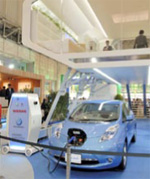 Credit: YOSHIFUSA HASHIZUME Nissan Motor: Smart House
Nissan exhibited a near-future house using the company's EV model Leaf as a storage battery. With a battery storage capacity of 24 kWh, Leaf is capable of providing nearly two days' worth of the electricity used by a regular household. The electricity supply system, which combines this battery with solar power and fuel cells, can ensure stable home power generation regardless of the weather. Using solar power generation and nighttime power to charge up the Leaf and supply electricity to households when necessary could control electricity consumption during peak hours and help secure electricity in the event of a power outage following a major disaster. The Smart House's advantage of electricity self-sufficiency attracted a great deal of attention. |
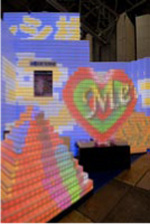 Credit: YOSHIFUSA HASHIZUME Kodenshi: LED BLOCK
LED BLOCK, a new type of decorative and luminous block, has a built-in full-color LED display that shows numerous different images. It can be used in many different applications from desktop accessories to objects in large halls. Wiring can be completed by simply assembling the blocks with the use of a built-in connector. Characteristically, the product allows users to easily make and illuminate cubic exhibitions of arbitrary forms. A microcomputer is embedded in each of the blocks. With the accompanying software, users can make luminescent patterns on the computer at will. Assembled cubic blocks can also show full-color videos. Many visitors stopped involuntarily in front of the ever-changing gradation of luminescence. |
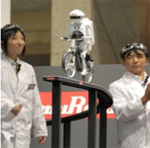 Credit: YOSHIFUSA HASHIZUME Murata Manufacturing: Murata Seisaku-kun, Murataseiko-chan and Electric Walking Assist Car
Murata Seisaku-kun, a robot riding a bicycle (photo), and Murataseiko-chan, a robot riding a unicycle, have become familiar characters at CEATEC JAPAN. The gyro sensor detects their degree of tilt, and rotating the reaction wheel mounted on the body helps the robots to move while maintaining a subtle balance. In the demonstration, the pair of robots was applauded after running up a curved, narrow, sloping road while remaining upright. The unique control technology was applied to the development of the Electric Walking Assist Car, which assists walking by automatically moving in the direction of the user's preference in an attempt to maintain balance. Hopefully this technology will also be applied to strollers and shopping carts. |
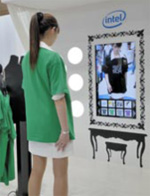 Credit: YOSHIFUSA HASHIZUME Toppan Printing: Virtual Fitting System
Developed collaboratively by Toppan Printing and a German research institute, the virtual fitting system allows users to simulate the fitting of clothes and accessories without actually changing their clothes. Image recognition and synthetic technology are used to synthesize the images of clothes etc. on the display in accordance with the user's body shape as shown in the camera. Traditionally, the technology was nothing more than simply synthesizing the images of prepared clothes on the display without reflecting the body shape or the folds of clothes. Through an analysis of folds, the latest technology makes it possible to simulate a lifelike fitting experience. The introduction of the system is scheduled in some apparel shops and distribution industries. These shops will benefit from a reduction in fitting rooms and shorter fitting times, while users will no longer need to repeat trial fittings. The presentation of the system at CEATEC coincided with its sales launch. |
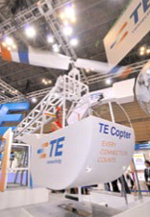 Credit: YOSHIFUSA HASHIZUME TE Connectivity: TE Copter
The most conspicuous feature in the exhibition was the human-powered helicopter. Manually turning the handle on the flight deck rotates the propeller and elevates the seesaw-type helicopter, fixed on a pillar, up to a height of a maximum of approximately 1.6 meters. The human-powered helicopter makes a seemingly low-tech impression. However, it employs the same cables and connectors as those utilized in the asteroid probe Hayabusa. The cutting-edge high technology is abundantly incorporated in the internal part. It measures the body weight of the passenger while moving a weight on the opposite side of the seesaw in an attempt to maintain balance. This makes it much easier to elevate the helicopter, even with the arm strength of a child or woman. |
© 2009 Cabinet Office, Government of Japan






